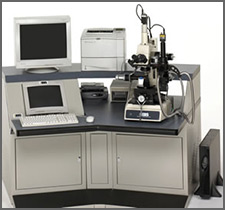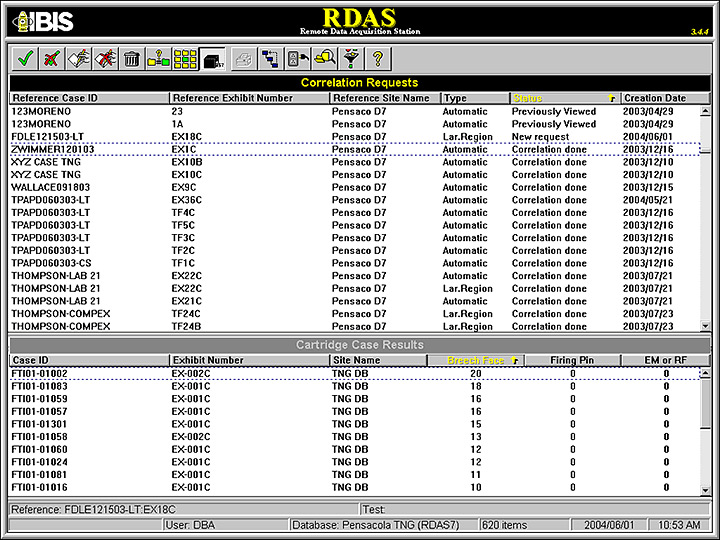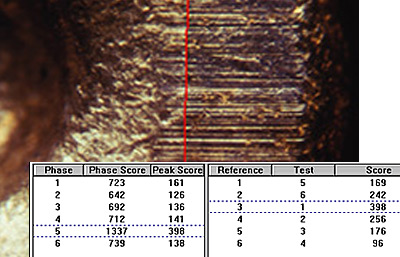Home | Glossary | Resources | Help | Contact Us | Course Map
Archival Notice
This is an archive page that is no longer being updated. It may contain outdated information and links may no longer function as originally intended.
Case Linkage
Historically, many forensic firearm laboratories maintained files containing fired evidence (cartridge cases, shotshell cases, and fired bullets) from unsolved cases. This evidence was typically from shooting incidents in which a firearm had not been located or connected to the evidence collected at the crime scene. Cartridge cases from the most recent incident were compared to all previous cartridge cases and shotshell cases of the appropriate caliber/gauge and cartridge type retained in physical files.
These evidence files were named
- unsolved case file,
- open case file,
- reference fired specimen file,
- open case ammunition file.
Over time, many jurisdictions found that the storage and access to the large number of files was impractical. This resulted in the restriction of file searches to particular years or cases, as indicated by other investigative information.
Advanced Case Linkage and
Fired Cartridge Case Comparisons
Advanced computer-based tools are widely used by laboratories for screening thousands of firearms-related evidence items for potential linkages of incidents. These tools include computer and optical hardware as well as software for managing a combination of specialized algorithms, pattern recognition, and digital imaging. The product is a preliminary computer-based selection of high-probability associations that may be subsequently confirmed or eliminated by a firearms examiner.
The current predominant system for accomplishing these comparisons is the Integrated Ballistics Identification System (IBIS), developed by Forensic Technology, Incorporated (FTI).
It should be stressed that a high correlation score by the IBIS system is not a sufficient basis for court testimony; an examination by a qualified firearm examiner is required for courtroom presentation. Technology has provided for more efficient handling of steadily mounting caseloads and the increasing volume of firearms-related evidence.
Selected Bibliography
The Selected Bibliography is a list of the writings that have been used in the assemblage of the training program and is not a complete record of all the works and sources consulted. It is a compilation of the substance and range of readings and extensive experience of the subject matter experts.
- AFTE Criteria for Identification Committee. 1992. Theory of identification, range striae comparison reports and modified glossary definitions AFTE criteria for identification committee report. AFTE J 24 (2): 336-340.
- Al Khalifa, A.K. 1983. Headstamps with Arabic markings. AFTE J 15 (2): 64.
- Biasotti, A., and J. Murdock. 1984. Criteria for identification in firearms and toolmark identification. AFTE J 16 (4): 16-24.
- Biasotti, A.A, and J.E. Murdock. 1997. Firearms and toolmark identification: Legal issues and scientific status. In Modern Scientific Evidence: The Law and Science of Expert Testimony , ed D.L. Faigman, D.H. Kay, M.J. Saks, and J. Sanders, 124 151. St Paul: West Publishing Co.
- Brackett, J. 1970. A study of idealized striated marks and their comparisons using models. J of Forensic Sci Soc . 10 (1): 27-56.
- Burrard, G. 1962. The Identification of Firearms and Forensic Ballistics . New York: A.S. Barnes & Co.
- Datig, Fred. 1963. Cartridges for Collectors . 4 vols. Los Angeles: Borden Publishing.
- Davis, J.E. 1958. Introduction to Tool Marks, Firearms and the Striagr . Springfield: Charles C Thomas Pub Ltd.
- Garland, P.V. 1974. Color code identification of small arms cartridges. AFTE J 6 (2): 27.
- Gunther, J.D., and C.O. Gunther. 1935. The Identification of Firearms . New York: John Wiley and Sons Inc.
- Hamby, J. 1974. Identification of projectiles. AFTE J 6 (5/6): 22.
- Hatcher, J. 1935. Textbook of Firearms Investigation, Identification and Evidence . Plantersville: Small-Arms Technical Publishing Co.
- Hatcher, J. 1947. Hatchers Notebook . Harrisburg: Military Service Publishing Co.
- Hatcher, J.S., F.J. Jury, and J. Weller. 1957. Firearms Investigation, Identification, and Evidence . Harrisburg: Stackpole Books.
- Heard, B. 1997. Handbook of Firearms and Ballistics - Examining and Interpreting Forensic Evidence . West Sussex: John Wiley & Sons, Inc.
- Horn, W. 1962. Headstamps and Cartridge Identification Data . Burlington: Sheldon Press.
- Mathews, J.H. 1962. Firearms Identification, Volume I . Springfield: Charles C. Thomas.
- Mathews, J.H. 1962. Firearms Identification, Volume II . Springfield: Charles C. Thomas.
- Mathews, J.H. 1973. Firearms Identification, Volume III . Springfield: Charles C. Thomas.
- Nichols, R. 2004. Firearm and toolmark identification: The scientific reliability and validity of the AFTE theory of identification discussed within the framework of a study of 10 consecutively manufactured extractors. AFTE J 36 (1): 67-88.
- Shem, R. and P. Striupaitis. 1983. Comparison of 501 consecutively fired bullets and cartridge cases from a .25 caliber Raven pistol. AFTE J 15 (3): 109-112.
- Smith, E. 2005. Cartridge case and bullet comparison validation study with firearms submitted in casework. AFTE J 37 (2): 130-135.
- Warniment, D. 2003. Brownsville investigation A historical cartridge case comparison. AFTE J 34 (4): 375.
- Welch, N.E. 1981. Matching a bullet to a cartridge case. AFTE J 13 (4): 79.
Additional Online Courses
- What Every First Responding Officer Should Know About DNA Evidence
- Collecting DNA Evidence at Property Crime Scenes
- DNA – A Prosecutor’s Practice Notebook
- Crime Scene and DNA Basics
- Laboratory Safety Programs
- DNA Amplification
- Population Genetics and Statistics
- Non-STR DNA Markers: SNPs, Y-STRs, LCN and mtDNA
- Firearms Examiner Training
- Forensic DNA Education for Law Enforcement Decisionmakers
- What Every Investigator and Evidence Technician Should Know About DNA Evidence
- Principles of Forensic DNA for Officers of the Court
- Law 101: Legal Guide for the Forensic Expert
- Laboratory Orientation and Testing of Body Fluids and Tissues
- DNA Extraction and Quantitation
- STR Data Analysis and Interpretation
- Communication Skills, Report Writing, and Courtroom Testimony
- Español for Law Enforcement
- Amplified DNA Product Separation for Forensic Analysts




